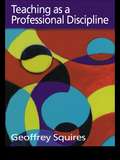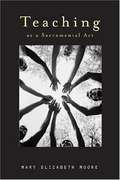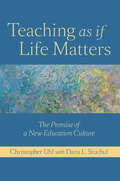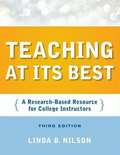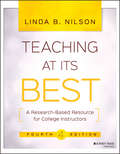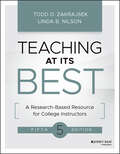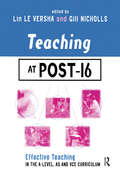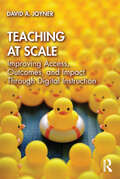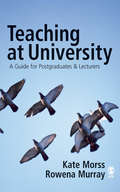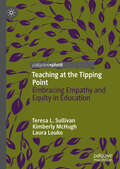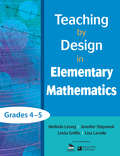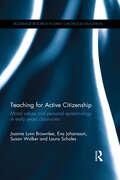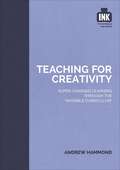- Table View
- List View
Teaching as Protest: Emancipating Classrooms Through Racial Consciousness
by Robert S. Harvey Susan GonzowitzTeaching as Protest explores how K-12 teachers can expand the boundaries of their profession with anti-oppressive, community-building pedagogies. Now more than ever, students are looking to their schools to make meaning of our nation’s complicated and compounded traumas, namely those at the intersection of race, class, gender, and power. This book provides historical and philosophical perspectives into liberatory instructional work, while offering planning, preparation, and practice tools whose modalities recognize identity and mindsets, emphasizing schools that predominantly serve Black students. By moving beyond conventional tools and tasks such as standards, lesson-planning, and grade-team meetings and into more emancipatory, student-centered approaches, teachers can answer the call to a more just and radical demonstration of protest intended to disrupt and dismantle oppression, racism, and bias.
Teaching as a Design Science: Building Pedagogical Patterns for Learning and Technology
by Diana LaurillardTeaching is changing. It is no longer simply about passing on knowledge to the next generation. Teachers in the twenty-first century, in all educational sectors, have to cope with an ever-changing cultural and technological environment. Teaching is now a design science. Like other design professionals – architects, engineers, programmers – teachers have to work out creative and evidence-based ways of improving what they do. Yet teaching is not treated as a design profession. Every day, teachers design and test new ways of teaching, using learning technology to help their students. Sadly, their discoveries often remain local. By representing and communicating their best ideas as structured pedagogical patterns, teachers could develop this vital professional knowledge collectively. Teacher professional development has not embedded in the teacher’s everyday role the idea that they could discover something worth communicating to other teachers, or build on each others’ ideas. Could the culture change? From this unique perspective on the nature of teaching, Diana Laurillard argues that a twenty-first century education system needs teachers who work collaboratively to design effective and innovative teaching.
Teaching as a Professional Discipline: A Multi-dimensional Model
by Dr Geoffrey Squires Geoffrey SquiresFirst Published in 2004. Routledge is an imprint of Taylor & Francis, an informa company.
Teaching as a Sacramental Act
by Mary Elizabeth Mullino MooreMoore asserts that Christian vocation, and the teaching vocation in particular, can be best understood as sacramental, mediating the grace of God through ordinary creation for the sanctification of human life and the well-being of all creation. She develops her argument through three important factors: a historical-theological analysis of the Christian sacraments and sacramentality; a phenomenological study of teaching events; and a description of six sacramental movements and corresponding teaching practices as informed by Jewish-Christian traditions and Eucharistic practices. The nine detailed chapters include: Searching for the Sacred; Sacred Teaching: Education as Sacrament; Expecting the Unexpected; Remembering the Dismembered; Seeking Reversals; Giving Thanks; Nourishing Life; Reconstructing Community and Repairing the World; and Mapping the Future of Sacramental Teaching. Teaching as a Sacramental Act is ideal for students, pastors, Christian educators, spiritual directors, and pastoral caregivers who want to rethink and reshape the teaching ministry of the church.
Teaching as if Learning Matters: Pedagogies of Becoming by Next-Generation Faculty (Scholarship of Teaching and Learning)
by Javier Ramirez Lauren Miller Griffith Jing Yang Mack Hagood Keely Cassidy Jonathan P. Rossing Laura J. Carpenter Jacquelyn Petzold Barbie Klein Andrew M. Koke Rachel La Touche Natalie Christian Sarah Socorro Hurtado Juliane Wuensch Elizabeth Konwest Kristen Hengtgen Alyssa M. Lederer Silja Weber Adam Coombs Carol Subiño Sullivan Leslie E. Drane Ryan G. Erbe Polly A. Graham Sarah M. Keesom Kristyn E. Sylvia Laura Clapper Jessica Leach Lisa Wiltbank Michelle R. Marasco Mark S. Nagle Letizia Montroni Maksymilian Szostalo J. Christopher Upton Maureen Chinwe Onyeziri Francesca A. Williamson Tyler B. ChristensenTeaching is an essential skill in becoming a faculty member in any institution of higher education. Yet how is that skill actually acquired by graduate students? Teaching as if Learning Matters collects first-person narratives from graduate students and new PhDs that explore how the skills required to teach at a college level are developed. It examines the key issues that graduate students face as they learn to teach effectively when in fact they are still learning and being taught. Featuring contributions from over thirty graduate students from a variety of disciplines at Indiana University, Teaching as if Learning Matters allows these students to explore this topic from their own unique perspectives. They reflect on the importance of teaching to them personally and professionally, telling of both successes and struggles as they learn and embrace teaching for the first time in higher education.
Teaching as if Life Matters: The Promise of a New Education Culture
by Christopher UhlWhat would it be like to teach as if life matters? To move beyond the typical regimen of classroom exercises, homework, and standardized tests and to guide students through life’s most important lessons? Dissatisfied with traditional educational models, Christopher Uhl and Dana L. Stuchul asked themselves these questions. What they discovered will open the eyes of today’s educators to a whole new way of teaching.The authors promote an approach that fosters self-knowledge, creativity, curiosity, and an appreciation for our planet. Central to their philosophy is the question of what we humans need in order to live meaningful lives. The answer: healthy relationships with ourselves, each other, and the world. Teaching as if Life Matters is an open letter to teachers offering guidance and encouragement for nurturing students in ways that make teaching and learning meaningful. In short, it is a passionate plea for transformative teaching. Informed by the alternative educational philosophies of John Dewey, Maria Montessori, Rudolf Steiner, and Ivan Illich, this book invites teachers and students to participate in a new culture of education.This fascinating and urgently needed book will inspire today’s educators to inspire their students.
Teaching as if Students Matter: A Guide to Creating Classrooms Based on Relationships and Engaged Learning
by Jaye Zola John ZolaTeaching as if Students Matter supports the goal of new teachers to create engaging classrooms where students want to learn. It provides concrete and specific methods for building relationships with all students, managing their behaviors in positive ways, and planning for engaged and authentic instruction. Throughout, the book emphasizes the critical role of culturally responsive teachers in creating inclusive curriculum and meaningful relationships to help all students learn and succeed. This book provides specific advice on how to build a classroom culture where discussion can flourish, as well as ideas for working with colleagues, and maintaining a healthy work-life balance. As one reviewer wrote "after reading this book, I really […] believe I can do this!"
Teaching as the Art of Staging: A Scenario-Based College Pedagogy in Action
by Anthony WestonCollege teachers all too often still play Sage on the Stage – lecturing to rooms full of passive and supposedly absorbed students. The cutting-edge opposite is still supposed to be the Guide on the Side – facilitating wherever students themselves are already going, mentoring and coaching them along the way. But who says that these are the only – or the best – alternatives? This book advances another and sharply different model: the Impresario with a Scenario, a teacher who serves as class mobilizer, improviser, and energizer, staging dramatic, often unexpected and self-unfolding learning challenges and adventures with students.In this book, the author argues that to pose a single alternative to lecturing is profoundly limiting. In fact, he says there is no reason to have to choose between “student-centered” and “teacher-centered” pedagogies. The best ways to teach and learn are both. The same applies to the false choice between “active” students and “active” teachers – there can be more than enough activity for everyone. In particular, the author argues that we need a model in which the teacher is notably pro-active – a kind of activity for which certain theatrical metaphors seem especially appropriate.Picture a college teacher who regularly sets up classroom scenarios – challenging problems, unscripted dramas, role-plays, simulations, and the like – such that the scenario itself frames and drives most of the action and learning that follows. For teaching as staging, the primary work of the teacher is staging such scenarios. The basic goal is to put students into an urgently engaging and self-unfolding scenario, trusting them to carry it forward, while being prepared to join in as needed.This book offers a conceptual and practical framework for Teaching as Staging, grounding the approach with illustrative and sometimes provocative narrative from the literature as well as the author’s own practice.Teaching as the Art of Staging offers a visionary challenge to the prevailing models of pedagogy. The book presents a thoroughly practical model that opens up new possibilities for anyone interested in dramatic new directions in teaching and learning.
Teaching at Its Best
by Nilson Linda B.This expanded and updated edition of the best-selling handbook is an essential toolbox, full of hundreds of practical teaching techniques, classroom activities and exercises, for the new or experienced college instructor. This new edition includes updated information on the Millennial student, more research from cognitive psychology, a focus on outcomes maps, the latest legal options on copyright issues, and more. It will also include entirely new chapters on matching teaching methods with learning outcomes, inquiry-guide learning, and using visuals to teach, as well as section on the Socratic method, SCALE-UP classrooms, and more.
Teaching at Its Best: A Research-Based Resource for College Instructors
by Linda B. NilsonThe classic teaching toolbox, updated with new research and ideas Teaching at Its Best is the bestselling, research-based toolbox for college instructors at any level, in any higher education setting. Packed with practical guidance, proven techniques, and expert perspectives, this book helps instructors improve student learning both face-to-face and online. This new fourth edition features five new chapters on building critical thinking into course design, creating a welcoming classroom environment, helping students learn how to learn, giving and receiving feedback, and teaching in multiple modes, along with the latest research and new questions to facilitate faculty discussion. Topics include new coverage of the flipped classroom, cutting-edge technologies, self-regulated learning, the mental processes involved in learning and memory, and more, in the accessible format and easy-to-understand style that has made this book a much-valued resource among college faculty. Good instructors are always looking for ways to improve student learning. With college classrooms becoming increasingly varied by age, ability, and experience, the need for fresh ideas and techniques has never been greater. This book provides a wealth of research-backed practices that apply across the board. Teach students practical, real-world problem solving Interpret student ratings accurately Boost motivation and help students understand how they learn Explore alternative techniques, formats, activities, and exercises Given the ever-growing body of research on student learning, faculty now have many more choices of effective teaching strategies than they used to have, along with many more ways to achieve excellence in the classroom. Teaching at Its Best is an invaluable toolbox for refreshing your approach, and providing the exceptional education your students deserve.
Teaching at Its Best: A Research-Based Resource for College Instructors
by Linda B. Nilson Todd D. ZakrajsekA complete, accessible, evidence-based guide to better teaching in higher education This higher education playbook provides a wealth of research-backed practices for nearly every aspect of effective teaching throughout higher education. It is filled with practical guidance and proven techniques designed to help you improve student learning, both face-to-face and online. Already a bestselling research-based toolbox written for college instructors of any experience level, Teaching at Its Best just got even better. What is new? A lot. For this updated 5th edition, Todd Zakrajsek joins Linda Nilson to create a powerful collaboration, drawing on nearly 90 combined years as internationally recognized faculty developers and faculty members. One of the most comprehensive books on effective teaching and learning, the 5th edition of Teaching at its Best brings new concepts, new research, and additional perspectives to teaching in higher education. In this book, you will find helpful advice on active learning, interactive lecturing, self-regulated learning, the science of learning, giving and receiving feedback, and so much more. Each chapter has been revised where necessary to reflect current higher education pedagogy and now includes two reflection questions and one application prompt to reflect on your teaching and stimulate peer discussions. Discover the value of course design and how to write effective learning outcomes Learn which educational technology is worthwhile and which is a waste of time Create a welcoming classroom environment that boosts motivation Explore detailed explanations of techniques, formats, activities, and exercises—both in person and online Enjoy reading about teaching strategies and educational concepts Whether used as a resource for new and seasoned faculty, a guide for teaching assistants, or a tool to facilitate faculty development, this research-based book is highly regarded across all institutional types.
Teaching at Post-16: Effective Teaching in the A-Level, AS and GNVQ Curriculum
by Gill Nicholls Lin Le VershaThe post-16 sector is the focus of great change in education and this book provides all teaching professionals with a guide to exploring and developing successful teaching in this new environment.With contributions from education experts and subject specialists, this book addresses the issues that now face teachers at post-16. It guides readers through the new requirements in a simple and accessible way; looks at teaching and learning issues in detail and considers the professional development of those teaching at this level. Essential reading for all post-16 teachers in schools and colleges.
Teaching at Scale: Improving Access, Outcomes, and Impact Through Digital Instruction
by David A. JoynerTeaching at Scale explores the characteristics and parameters of large-scale online learning by identifying, in its perceived drawbacks, a wealth of educational opportunities in disguise. Scalable learning platforms have exploded in popularity over recent years, with MOOCS (massive open online courses), online degree programs, informal learning communities, and alternative credentials all drawing significant enrollments. But, as many educators are asking, are the challenges to delivering education at scale too great and the compromises too many? This book guides instructors to leverage their complex responsibilities—open-ended assessments at scale, individuated feedback to students, academic integrity in less controlled environments, and more—into significant assets. Informed by real-world institutional experience as well as key research in cognitive science and the learning sciences, each chapter provides practical strategies for educators and administrators seeking to solve problems and fulfill the high-quality, broad-access potential of large-scale instruction for lifelong learners.
Teaching at Scale: Improving Access, Outcomes, and Impact Through Digital Instruction
by David JoynerTeaching at Scale explores the characteristics and parameters of large-scale online learning by identifying, in its perceived drawbacks, a wealth of educational opportunities in disguise. Scalable learning platforms have exploded in popularity over recent years, with MOOCS (massive open online courses), online degree programs, informal learning communities, and alternative credentials all drawing significant enrollments. But, as many educators are asking, are the challenges to delivering education at scale too great and the compromises too many? This book guides instructors to leverage their complex responsibilities—open-ended assessments at scale, individuated feedback to students, academic integrity in less controlled environments, and more—into significant assets. Informed by real-world institutional experience as well as key research in cognitive science and the learning sciences, each chapter provides practical strategies for educators and administrators seeking to solve problems and fulfill the high-quality, broad-access potential of large-scale instruction for lifelong learners.
Teaching at University: A Guide for Postgraduates and Researchers (SAGE Study Skills Series)
by Kate Morss Dr Rowena MurrayAre you a postgraduate student just beginning to teach? Are you a contract researcher, teaching fellow or instructor who has been asked to do some teaching? If you are, you may feel you have been `thrown in at the deep end'. You may quite rightly, feel unprepared for the task, and, like other postgraduate teachers, you may be facing a number of dilemmas: you may not have much time to feel your way into this new role; you may not be happy with what looks like a `trial and error' model of learning to teach; you may even feel you have not had much choice in what you are to teach or what kinds of sessions you've been asked to facilitate. Someone in your department may have tried to reassure you -- `You know all this stuff. You'll be fine' -- on the basis of your first degree, but you may still be worried about whether or not you are really ready to teach. Teaching at University has been written to provide you with the basic skills required to enter those first lectures, tutorials, lab-sessions and assessments with confidence. Clear and engaging throughout, this guide will offer: " Accessible and generic language to support postgraduates in all disciplines " Basic but relevant advice " Portfolio sections at the end of each chapter " A direct and practical approach and style " An emphasis on helping you to get started and build up your confidence in the first few classes you teach " Integration of theory (in small doses) with practice With an application spanning the disciplines, Teaching at University is the essential companion for all teaching postgraduates and new lecturers.
Teaching at the Tipping Point: Embracing Empathy and Equity in Education
by Teresa L. Sullivan Kimberly McHugh Laura LoukoThis book chronicles the challenges, truths, and lessons of teaching and leading in a traditional high school today: the bureaucratic red tape, the fight for inclusivity, the mental health and safety concerns, and the urgent need for teacher support and wellness. From active shooter drills to digital distractions, from closing achievement gaps to preserving educator autonomy, the challenges are immense—but so are the opportunities for change. With an honest and insightful perspective, the authors share their compelling narrative account from their extensive experiences in the trenches as both a cautionary tale and a call to action—challenging educators, policymakers, and communities to rethink how schools can truly serve students and those who teach them.
Teaching by Design in Elementary Mathematics, Grades 2–3
by Jennifer Stepanek Melinda Leong Linda Griffin Lisa LavelleStrengthen mathematics lessons through collaborative learning with this research-based professional development program. Included are grade-appropriate number and operations topics aligned with the Common Core State Standards.
Teaching by Design in Elementary Mathematics, Grades 4–5
by Jennifer Stepanek Melinda Leong Linda Griffin Lisa LavelleStrengthen mathematics lessons through collaborative learning with this research-based professional development program. Included are grade-appropriate number and operations topics aligned with the Common Core State Standards.
Teaching by Design in Elementary Mathematics, Grades K–1
by Jennifer Stepanek Melinda Leong Linda Griffin Lisa LavelleStrengthen mathematics lessons through collaborative learning with this research-based professional development program. Included are grade-appropriate number and operations topics aligned with the Common Core State Standards.
Teaching for Active Citizenship: Moral values and personal epistemology in early years classrooms (Routledge Research in Early Childhood Education)
by Eva Johansson Laura Scholes Joanne Lunn Brownlee Susan WalkerThere is strong social and political interest in active citizenship and values in education internationally. Active citizenship requires children to experience and internalize moral values for human rights, developing their own opinions and moral responsibility. While investment in young children is recognised as an important factor in the development of citizenship for a cohesive society, less is known about how early years teachers can encourage this in the classroom. This book will present new directions on how teachers can promote children's learning of moral values for citizenship in classrooms. The research provided offers important insights into teaching for active citizenship by: • providing an analysis of educational contexts for moral values for active citizenship • highlighting teachers’ beliefs about knowing and knowledge (personal epistemologies) and how these relate to children’s learning and understanding about social and moral values • discussing the impact of teachers’ beliefs on teaching practices. Evidence suggests that investment in the early years is vital for all learning, and specifically for developing an understanding of active citizenship for tolerant and cohesive societies. This book will be essential reading for the professional education of early years teachers interested in teaching for active citizenship.
Teaching for CHANGE in the ELA Classroom: Integrating Social Justice and Critical Literacy for Grades 9-12
by Dan StockwellThis book can help you incorporate critical literacy pedagogy into your high school English Language Arts (ELA) classroom, so that your students can use what they study in class to work toward making a more just and equitable world.Through the acronym CHANGE, the book explores how critical literacy pedagogy can support students as they Challenge injustice to Help make a difference in the world by Asking and answering tough questions and Noticing ways to Get involved and Engaged in making the world a better place. It first centers on the theory behind critical literacy pedagogy with Bob Fecho’s concept of wobble, the tensions teachers experience when different points of view collide in the classroom, and why being mindful of and responding to moments of wobble can help educators grow in their teaching practice. The book then provides practical, specific suggestions by grade level for high school ELA teachers to implement critical literacy pedagogy in their classrooms, and address the tensions and moments of discomfort and uncertainty they might experience while providing critical literacy pedagogy.With detailed lesson plans and case study examples from in-service ELA teachers, this book is an incredible resource for high school language arts teachers who are interested in teaching for social justice and integrating critical literacy pedagogy into their classrooms.
Teaching for Character: Super-charged learning through 'The Invisible Curriculum'
by Andrew HammondThe Invisible Curriculum series helps teachers discover the secret ingredients that really unlock a child's learning potential. Teaching for Character offers practical advice to help encourage grit and determination in children - important foundations in any future success in or out of school. Is it possible to teach for character and raise academic standards? This book argues the case for character education.
Teaching for Character: Super-charged learning through 'The Invisible Curriculum'
by Andrew HammondThe Invisible Curriculum series helps teachers discover the secret ingredients that really unlock a child's learning potential. Teaching for Character offers practical advice to help encourage grit and determination in children - important foundations in any future success in or out of school. Is it possible to teach for character and raise academic standards? This book argues the case for character education.
Teaching for Comprehending and Fluency: Thinking, Talking, and Writing About Reading, K-8
by Gay Su Pinnell Irene C. FountasBook study groups and professional learning communities, click here to save 15% when you order 15 copies of Teaching for Comprehending and Fluency, K-8. Teaching for Comprehending and Fluency, K-8 is the next new breakthrough from Irene Fountas and Gay Su Pinnell. Offering a complete picture of how to skillfully teach meaning making and fluency within any instructional context, Teaching for Comprehending and Fluency, K-8, supports you with frameworks for high-quality instruction that describe appropriate expectations for comprehending, fluency, and vocabulary development. Fountas and Pinnell's teaching and assessment frames will give you a firm understanding of your students' reading levels: where they are, where they should be, and what they need to do to get there-for any reader, in any grade, at any moment. You'll also gain insight about the specific demands that fiction and nonfiction texts place on readers and about how effective readers think within a text, beyond a text, and about a text to gain rich understandings. As you learn about how the characteristics of texts help or hinder a reader's improvement, you'll find effective teaching strategies for: comprehending, word solving, fluency, and vocabulary writing about reading in a variety of genres and using writing as a tool for thinking using guided reading with fiction and nonfiction books discussing books during interactive read-aloud and literature study taking part in shared and performance reading. Fountas and Pinnell's teaching tips, smart strategies, proven classroom ideas, and professional-learning opportunities will lead the way as you discover how to help readers develop effective systems of strategic actions over time. You'll also learn how to take running records of reading behavior to assess comprehension and fluency then use those assessments to inform and differentiate your teaching. In addition, Fountas and Pinnell have also added a dynamic companion resource to Teaching for Comprehending and Fluency, K-8: a DVD containing short, focused video segments that illustrate concepts from the book and demonstrate exemplar teaching in real classroom settings. The DVD is also a repository of useful materials to support your work-including blackline masters, forms, checklists, and numerous other classroom tools. Fountas and Pinnell have developed detailed teaching guides for Teaching for Comprehending and Fluency. Perfect for staff development leaders or teacher educators, these guides offer all the specifics on leading a professional development program or preservice course on comphrension instruction with Teaching for Comprehending and Fluency as the core text. Each of the guides is written to address a specific course of study and is available for free download along with its accompanying course syllabus: Professional Development Program: Individual Study/Group Study (20 sessions) Preservice Teachers: One Semester Course (14-week college/university course) Preservice Teachers: One Quarter Course (11-week college/university course) Graduate Students: One Semester Course (14-week college/university course) Graduate Students: One Quarter Course (11-week college/university course) Click on the "Companion Resources" tab to download each of the guides. Discover powerful ways to help your students read with deep understanding and fluency. Read Teaching for Comprehending and Fluency, K-8 and be part of the big breakthrough in literacy instruction.
Teaching for Creativity: Super-charged learning through 'The Invisible Curriculum'
by Andrew HammondThe Invisible Curriculum Series gives teachers the secret ingredients to unlock the full potential of children's learning abilities. Too often in formal schooling, creativity and curiosity are taught out of children. Teaching for Creativity offers practical advice on how to ensure that this does not happen. This book will help teachers to preserve children's innate creative capacities at the same time as maintaining academic standards in the classroom.


